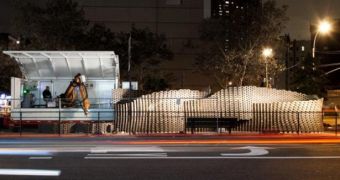New York City is highly renowned for its brick buildings, which have a characteristic reddish hue, and give certain streets a unique look. Over a period of three weeks, architects Fabio Gramazio and Matthias Kohler, both of whom are professors and researchers at ETH Zurich, in Switzerland, will guide their amazing robot in constructing the complex infinite loop known as the Pike Loop. The construction of the brick wall is entirely digitally controlled, and the algorithms used for that were developed by the Professorship of Architecture and Digital Fabrication, at ETH Zurich, ScienceDaily reports.
“Digital characteristics can enrich a material and thus influence its architectural expression and functionality,” the two experts say of the approach they have taken towards designing their sculpture. They call the new method “digital materiality,” as it combines elements of conventional architecture with digital programming. The shapes and construction principles are first programmed in a computer, and then digitally transferred onto the material. This transfer results in a 3D composition. “We marry the digital reality of the computer with the material reality of a building,” the two say.
The robot, which has been named R-O-B, has a range of about 4.5 meters, and needs to build a wall that is around 22 meters long. Some 7,000 bricks are already prepared for emplacement, and they are to be stacked together by no later than October 27. Each individual brick will be attached to the other via quick-drying glue, but will not be set precisely on top of the previous one. Pike Loop is among the first sculptures of this type to be constructed directly on top of its future exhibition site.
These slight irregularities will create the 3D effect, and each of the slight errors has been pre-programmed into R-O-B's computers. The infinite loop gets its dynamic expression from the fact that the wall appears to be coming up and down from the ground at some points, after which time it crosses itself on several occasions. In addition to creating something completely new, the two ETH architects also want to use the new construction technology to assess possible avenues of development for architectural research.

 14 DAY TRIAL //
14 DAY TRIAL //